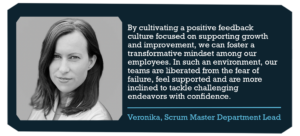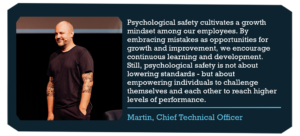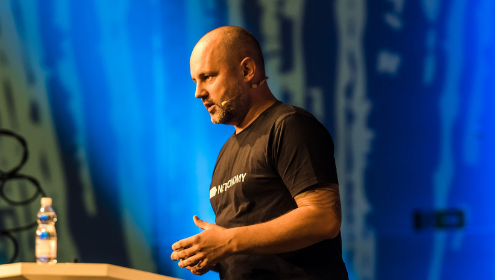
Embracing Failure for Success: The Power of Agile Practices and Psychological Safety

It may seem counterintuitive, but embracing failure can be one of the most effective ways for companies to drive success.
Organizations that are willing to take risks, explore new avenues, and learn from their mistakes are more likely to foster innovation, agility and adaptability – giving them a competitive edge on the market.
However, companies need more than just a willingness to fail. It needs to be accompanied by a culture that fosters a collective spirit of collaboration and innovation, and which allows people to safely grow and learn.
This is where the concept of psychological safety comes into play. In a psychologically safe environment, people are not afraid to take risks, express their ideas, or show vulnerability, since they know that they won’t face punishment or embarrassment for doing so. This kind of environment is essential in any agile environment because it creates an atmosphere where teams can freely experiment, explore new approaches, and take calculated risks without the paralyzing fear of failure.
In this blog post, we’ll explore the benefits of embracing failure and why it’s a great fit for an agile environment. We’ll also share how we combine these two practices with psychological safety to help our teams navigate uncertainty and drive success.
The Benefits of Embracing Failure
Embracing failure can be incredibly beneficial for companies in a number of ways:
- Increased Innovation
By embracing failure, companies create an environment where employees feel empowered to think creatively and challenge the status quo. In fact, an environment that enables people to think outside the box is one of the key ingredients that are needed for innovation to flourish.
Our CX Innovation Hub in Vienna offers just that: a creative space that is built to inspire people, supported by our team of innovation and design experts. That’s why our scrum master colleagues like to gather there for their “Open Space” evenings. This event is designed to be an open space full of discussion, collaboration, and community building for everybody who would like to join. All participants should bring their unique perspectives on technical or non-technical topics to the table and have room for open and honest discussions while sharing their insights and expertise.
- Faster Learning
Failure can be an effective teacher. By learning from their mistakes, teams can quickly iterate and improve upon their ideas. This can help them stay ahead of the curve in a fast-moving market.
- Better Risk Management
When companies embrace failure, they can take calculated risks instead of trying to avoid them altogether. By taking risks in a controlled environment, companies can learn what works and what doesn’t, and use this knowledge to make better decisions in the future.

Open Space Event at the CX Innovation Hub
Some of the most successful companies in the world have embraced failure as a driver of success. Google, for example, was famous for encouraging employees to take risks and experiment with new ideas, even if it means that some projects will fail. Amazon similarly embraces failure, with CEO Jeff Bezos famously saying, “I’ve made billions of dollars of failures at Amazon.com. Literally billions of dollars of failures.”
Continuing on the idea of embracing failure, we’ve actually found that this way of thinking goes hand in hand with agile practices. It’s a real game-changer because it creates an environment where failure isn’t something to be scared of, but rather a chance to grow and learn.
In the next section, we’re going to dig into all the benefits that come with embracing agile methods.
Driving Innovation through Agile
Agile practices are a set of methodologies that help companies be more flexible and responsive to changes in the market. They emphasize collaboration, iteration, and continuous improvement and are an integral part of our operations.
One of the biggest benefits of agile practices is that they promote experimentation and innovation by breaking down projects into smaller, more manageable chunks, so teams can test out new ideas and learn from their mistakes. This iterative approach allows our teams to quickly pivot and adapt our strategies to a new context.
Another benefit of agile practices is that they encourage collaboration and communication. By working together in cross-functional teams, employees can share their expertise and ideas, leading to more innovative solutions.
Imagine a scenario where a software development team is tasked with creating a new mobile application. In a traditional hierarchical structure, the designers would work separately on the app’s user interface, the developers would focus solely on coding, and the marketers would devise their own strategies. However, by embracing agile practices, these team members come together to form a cohesive unit. Through frequent interactions and open discussions, the designers contribute their creative insights to enhance the user experience, while the developers provide technical expertise to ensure smooth functionality. Simultaneously, the marketers offer valuable input on target audiences and competitive positioning. The resulting mobile application is the best of all three worlds – it seamlessly integrates user-friendly design, robust functionality, and effective marketing strategies.
This collaborative approach also fosters a sense of ownership and accountability among team members, which helps drive the overall success of the teams and the company.

Creating and Nurturing Psychological Safety
The first step towards agile is creating a psychologically safe environment and cultivating a culture that embraces healthy attitudes towards errors. This serves as the foundation for agile practices and is closely linked to a business’ success.
When team members feel safe and supported in expressing their ideas, taking risks, and making mistakes, they are more likely to contribute their full potential and engage in creative problem-solving.
Embracing healthy attitudes towards errors means seeing mistakes as valuable learning opportunities rather than as sources of shame or fear. By encouraging our teams to learn from failures and iterate on their approaches, they become more resilient, adaptive, and capable of responding effectively to evolving market dynamics. This mindset shift enables us to overcome obstacles, refine our strategies and achieve remarkable outcomes.

Fostering and maturing psychological safety is a top priority for us. Our leaders are committed to cultivating an environment that promotes open communication and feedback, while actively encouraging employees to express their ideas and perspectives.
This plays a pivotal role in our complex project world. By fostering an environment of psychological safety, we encourage more effective problem-solving within our teams. When employees feel secure in sharing their opinions and ideas, they are more likely to raise concerns and address issues before they escalate into significant challenges. The freedom to express diverse viewpoints and perspectives leads to richer discussions and more comprehensive analysis of the challenges at hand. This, in turn, enables us to make better-informed decisions and devise more effective solutions.

Authors and Contributors

Veronika Stubbings | Scrum Master Department Lead, NETCONOMY






